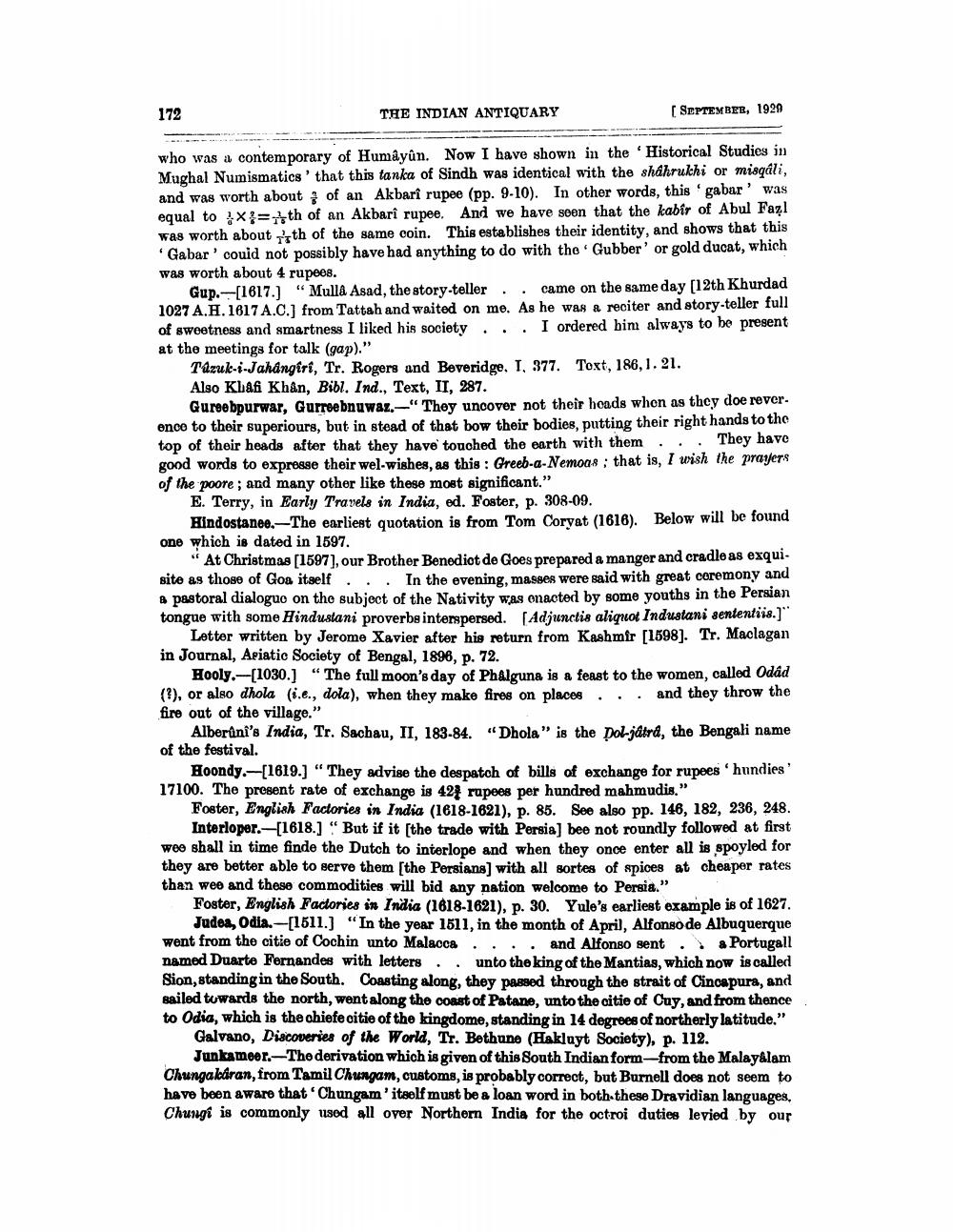________________
172
THE INDIAN ANTIQUARY
[SEPTEMBER, 1929
who was a contemporary of Humayun. Now I have shown in the Historical Studies in Mughal Numismatics' that this tanka of Sindh was identical with the shahrukchi or misqali, and was worth about of an Akbarî rupee (pp. 9-10). In other words, this gabar' was equal to 3x{=1th of an Akbarî rupee. And we have seen that the kabir of Abul Fazl was worth about th of the same coin. This establishes their identity, and shows that this
Gabar' couid not possibly have had anything to do with the Gubber' or gold ducat, which was worth about 4 rupees.
Gup.--- [1617.) "Mulla Asad, the story-teller.. came on the same day [12th Khurdad 1027 A.H. 1617 A.C.) from Tattah and waited on me. As he was a reciter and story-teller full of sweetness and smartness I liked his society... I ordered him always to be present at the meetings for talk (gap)."
Tezuk-s-Jahangiri, Tr. Rogers and Beveridge, T. 377. Toxt, 186,1. 21. Also Klafi Khan, Bibl. Ind., Text, II, 287.
Gureebpurwar, Gurrebnuwaz.-" They uncover not their hoads when as they doe rever. enoo to their superiours, but in stead of that bow their bodies, putting their right hands to the top of their heads after that they have touched the earth with them . They have good words to expresse their wel-wishes, as this : Greeb-a-Nemoas : that is, I wish the prayers of the poore ; and many other like these most significant."
E. Terry, in Early Travels in India, ed. Foster, p. 308-09.
Hindostanee.-The earliest quotation is from Tom Coryat (1616). Below will be found one which is dated in 1597.
"At Christmas (1597), our Brother Benedict de Goes prepared a manger and cradle as exqui. site as those of Goa itself. In the evening, masses were said with great ceremony and a pastoral dialogue on the subject of the Nativity was onaoted by some youths in the Persian tongue with some Hindustani proverbe interspersed. (Adjunctis aliquot Industani sententiis.]
Letter written by Jerome Xavier after his return from Kashmir (1598). Tr. Maclagan in Journal, Ariatic Society of Bengal, 1896, p. 72.
Hooly.-1030.] "The full moon's day of Phalguna is a feast to the women, called Odad (1), or also dhola (.e., dola), when they make fires on places ... and they throw the fire out of the village."
Alberîni's India, Tr. Sachau, II, 183-84. "Dhola" is the Dol-játrd, the Bengali name of the festival
Hoondy.- (1619.) “They advise the despatch of bills of exchange for rupees 'hundies' 17100. The prosent rate of exchange is 427 rupees per hundred mahmudis."
Foster, English Factories in India (1618-1621), p. 85. See also pp. 146, 182, 236, 248.
Interloper.[1618.] "But if it [the trade with Persia) bee not roundly followed at first we shall in time finde the Dutch to interlope and when they once enter all is spoyled for they are better able to serve them (the Persians) with all sortes of spices at cheaper rates than wee and these commodities will bid any nation welcome to Persia."
Foster, English Factories in India (1618-1621), p. 30. Yule's earliest example is of 1627.
Judea, Odia.-[1611.) "In the year 1611, in the month of April, Alfonso de Albuquerque went from the citie of Cochin unto Malacca .. . and Alfonso sent. a Portugall named Duarte Fernandes with letters. unto the king of the Mantias, which now is called Sion, standing in the South Coasting along, they passed through the strait of Cincapura, and sailed towards the north, went along the coast of Patane, unto the citie of Cuy, and from thence to Odia, which is the chiefe citie of the kingdome, standing in 14 degrees of northerly latitude."
Galvano, Discoveries of the World, Tr. Bethune (Hakluyt Society), p. 112.
Junkameer.-The derivation which is given of this South Indian form- from the Malayalam Chungakaran, from Tamil Chungam, customs, is probably correct, but Burnell does not seem to have been aware that Chungam' itself must be a loan word in both these Dravidian languages. Chungi is commonly used all over Northern India for the octroi duties levied by our




